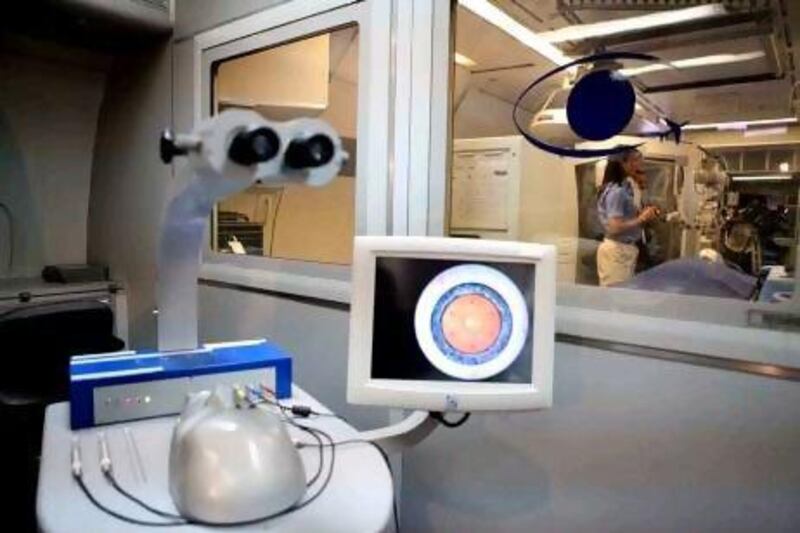ABU DHABI // The world’s only Flying Eye Hospital landed in the capital yesterday to highlight the importance of eye care.
The training hospital for health- care workers, which will close in a few months after 18 years of service, will tour five cities in the surrounding region to coincide with World Sight Day on October 11.
Having first visited Doha, the plane was in Abu Dhabi for seven days continuing today on to Ethiopia and Zambia and making its final stop in South Africa.
Previously a commercial carrier, the 40-year-old plane was specially adapted in 1990 to operate as a hospital.
It took four years to turn the plane into an eye hospital before it made its first official flight to Panama in 1994.
Orbis International, a non-profit organisation that aims to treat preventable eye diseases and curb blindness, operates the hospital.
Although the economic cost of blindness, which affects 39 million people worldwide, cannot be fully determined, it is a burden that the Flying Eye Hospital aims to alleviate.
“The sad thing is ... 32 million of those people didn’t have to be blind,” said Jack McHale, the director of aviation affairs for Orbis International.
“If they had access to care or if they could afford it, they could see.”
Cataracts, diabetic retinopathy and glaucoma, in which the optic nerve is damaged due to changes in eye pressure, are just some of the causes of blindness.
People must also be aware of the burden on families and people who must care for people who are blind, said Mr McHale.
This is the second plane the company has used; the first going into service in 1982. A third aircraft will continue the company’s good work.
“We have a new plane with a new cockpit, which is actually a freighter plane. So the new hospital is actually going to be built in a container,” said Mr McHale.
Alongside 22 permanent staff three to four visiting surgeons come in on a weekly basis.
The current plane contains an administration room; audio-visual and IT room; laser-treatment room; operating room; sterilisation room, recovery room and communications centre.
A filled bookcase sits at the end of the classroom.
Since 1982, Orbis has provided more than 18 million treatments and trained more than 300,000 medical professionals.
“Everything on the plane has to be certified – and certification drives the cost of a part, or a piece of equipment, by a factor of five,” said Mr McHale.
“When we installed this new flat screen,” he said, gesturing to a television situated at the front of the classroom, for doctors to view surgeries, “it cost US$5,000 (Dh18,300). “But by the time we put it on the plane ... it was $53,000.”
The new plane will reduce the overall cost of setting up the hospital – from the lighting to the carpets – from $62 million to $12m.
While treating children and adults is of great importance, the real objective of the flying hospital is to pass on skills and knowledge to ophthalmic surgeons and nurses in the countries where eye disease and blindness is highly prevalent.
“We teach so that when we leave, the doctors can continue to do the surgery,” Mr McHale added.
Cataract surgery can take as little as 15 minutes, although surgery performed on the plane takes longer than normal so training doctors can learn how to pick up necessary skills.
zalhassani@thenational.ae





